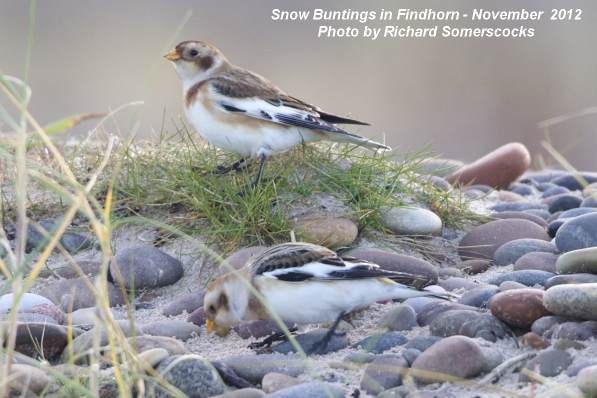Richard
Somerscocks moved to Findhorn in the north of Scotland
in the summer of 2012. Richard was an important
contributor to local wildlife news when he lived in
Emsworth and we miss his beautiful photos. However, he
has been sending us regular reports and photos from
his new home and this fully justifies a special web
page on our local web site.
Entries
are in reversed chronological order
12
MAY 2015
Richard
Somerscocks sends his greetings from Findhorn in
Northern Scotland where he now lives. Richard says he
looks at this Emsworth wildlife site from time to time
just to see what is happening in his old town. Richard
of course was a major contributor to the wildlife
diary until his move to Scotland in 2012. He was
particularly pleased to see the Spotted Redshank had
returned to Nore Barn for the 11th year running.
He thought we might be interested to hear that they
currently have a Spotted Redshank that has stopped off
on Findhorn Bay, presumably on its way back to its
breeding grounds in northern Scandinavia or Arctic
Russia. He does not think it is ours as it is rather
camera shy and is quite happy to mix with the local
Redshank! However, as shown in Richard's photo it is
quite a striking bird in its summer breeding plumage.
You can see why it is called a Spotted Redshank - we
never see them like that down here.
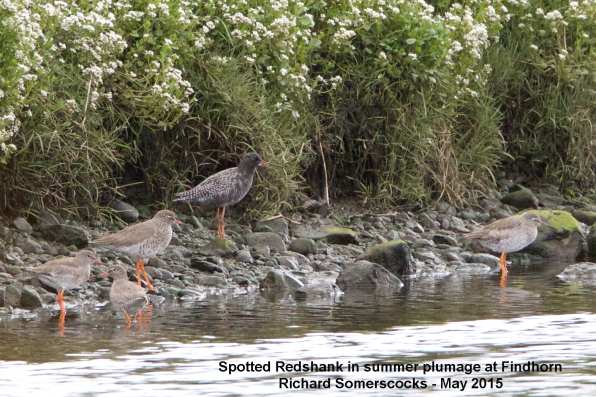
SUNDAY
21 APRIL 2013
Richard Somerscocks
reports on the latest news from his home in Findhorn,
Northern Scotland
"It's some while since
I last wrote so I thought I would give you an update
on some news from the north. Winter has dragged its
heels up here in Findhorn although it is starting to
warm up as the days get longer. This has also marked
quite a change in the birds in the bay as many of our
winter migrants have moved on and those that are left
have started to develop their summer plumage. We have
also started to see summer migrants appear.
It is amazing how
things survive in this harsh environment. I attach a
picture of a view of the western Cairngorms -
Braeriach and Cairn Toul - taken from Ben Macdui. Yes,
that was taken yesterday and it has probably had that
sort of snow cover for about 5 months now!
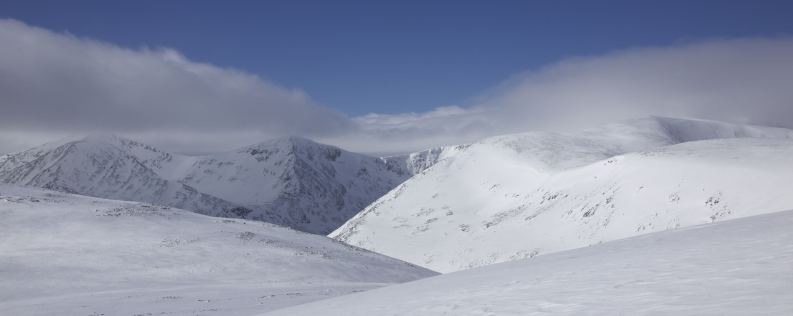
Having said all that I
went up onto the Cairngorm plateau yesterday in search
of a Snowy Owl that had been reported in a fairly
remote area near the summit of Ben Macdui (2nd highest
hill in UK). I didn't have any luck finding it - it
may have moved on - but I had a very enjoyable high
level walk looking at the Ptarmigan and Snow Buntings
which were plentiful. These birds are resident all
year round and the high plateau is their breeding
area.
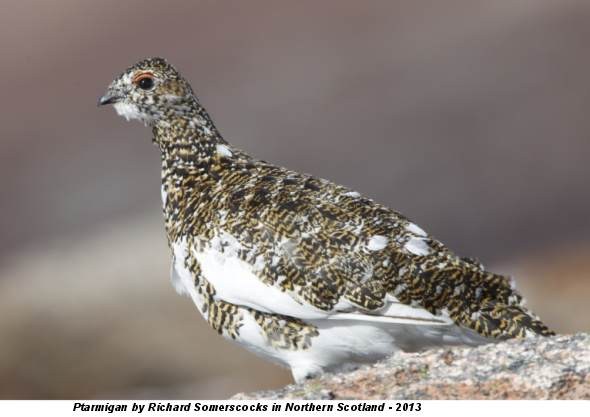
Back at Findhorn Bay
there are still plenty of Red-breasted Mergansers
around as well as Goldeneye. The Grey Herons can
regularly be seen catching Sea Trout along the shore
and the Ringed Plovers are getting ready to start
breeding. The Osprey arrived back earlier this month
but they are always a bit scarce at the start of the
season - presumably busy nesting and since they don't
yet have young to feed they are not fishing as
regularly as they will be later. Seals are also
plentiful at the entrance to the bay.
Grey
Herons can regularly be seen catching Sea Trout

About 20 miles east
along the coast I saw some Black Guillemot a couple of
weeks ago. These are very much a bird of northern
Britain so I don't expect you see them on the south
coast.
Here
is a Crested Tit I managed to see some in a local wood
recently on a feeder that someone had put out.

THURSDAY
21 FEBRUARY 2013
We are having some
nice settled weather at the moment, albeit with a
rather cold wind so plenty of opportunity to get out
birdwatching. Findhorn Bay has its usual assortment of
waders at the moment: Redshank, Curlew, Turnstone,
Bar-tailed Godwit, Oystercatcher, Knot and about 1300
Dunlin. Today I also saw a couple of Lapwing for the
first time in ages.
Plenty of ducks at the
moment including about 130 Pintail, 150 Mallard, 350
Wigeon and around 45 Shelduck as well as Red-breasted
Mergansers and Goldeneye. A few sea ducks are also
present - mostly Long-tailed Ducks and Eider, but
there was also a drake Common Scoter that came
into the bay about 10 days ago. This is quite unusual
as they normally stay well out to sea but it gave some
good views.

This morning there was
a Guillemot looking quite handsome in its
summer plumage that came onto the beach at Findhorn.
These also stay well out to sea usually and although
it looked quite healthy it obviously wasn't as people
and dogs were able to get quite close, and they don't
normally come ashore. I called the Scottish SPCA and
they came and rescued it. It was very thin and the
SPCA commented that for some reason there is a
tendency for this species to come ashore and die in
late winter - they don't quite know why. Hopefully
this bird will recover.
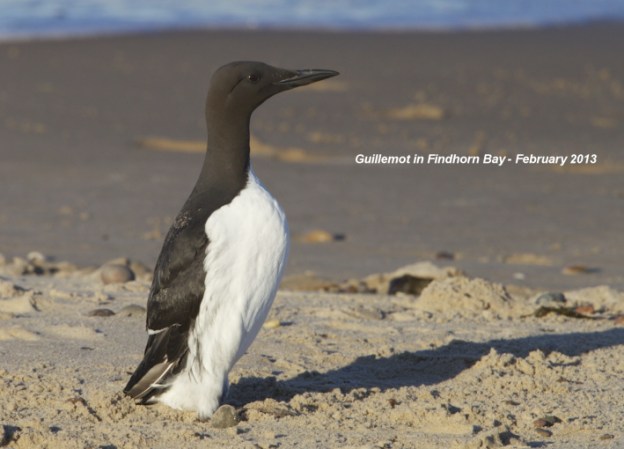
Elsewhere in the area
I still haven't managed to get a decent sighting of a
Crested Tit but I will keep looking. We do however get
a few Tree Sparrows in the area.
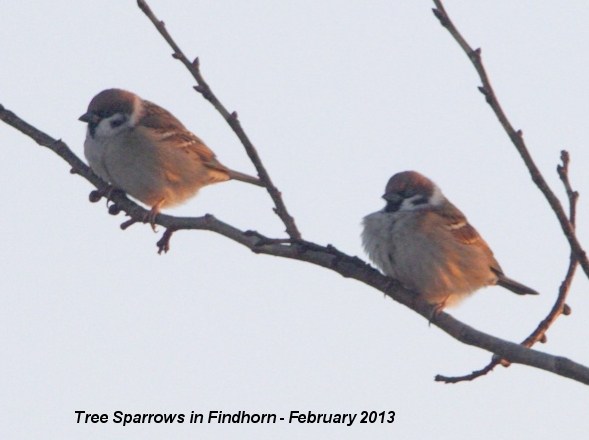
While in Culbin Forest
recently I took a few pictures of the Lichen
which is quite prolific in places. Hopefully my
identification is correct. Here is just one of them.
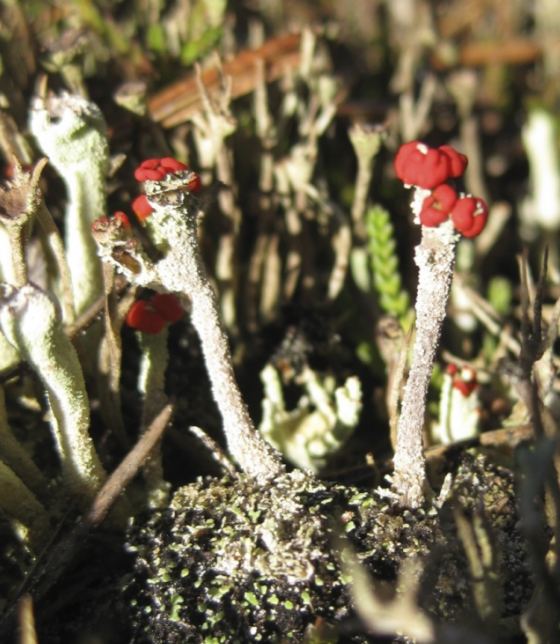
SATURDAY
2 FEBRUARY 2013
Richard Somerscocks
sends his latest missive from his new home in the
frozen north of Scotland.
"Plenty of birds still
around at Findhorn at the moment. Pintails are
present in quite large numbers with 146 showing this
morning. The picture attached shows about 60 of them.
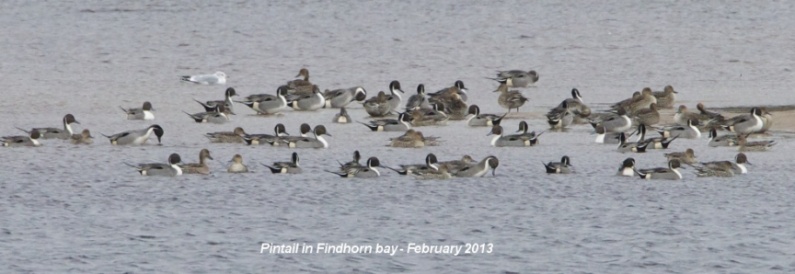
Roosting with the
Pintail were also quite a lot of Bar-tailed
Godwits. No sign of the Black-tailed Godwits at
the moment. They should start to pass through this
area in a couple of months.

The Red-breasted
Mergansers are still with us - this male ate 2 of
these fish within about 5 minutes. These flat fish
(Flounder?) don't look easy to swallow but they always
seem to catch them so they must like them. Just along
the coast this afternoon I also saw a group of 15 Snow
Bunting.

Shags as well
as Cormorant are still present in the bay and I
spotted some resting up on the jetty recently enabling
me to get some close up shots of their heads. At this
range you can see the difference between these 2 birds
that at a distance can look similar. Elsewhere in the
bay there are the usual selection of waders including
Redshank."
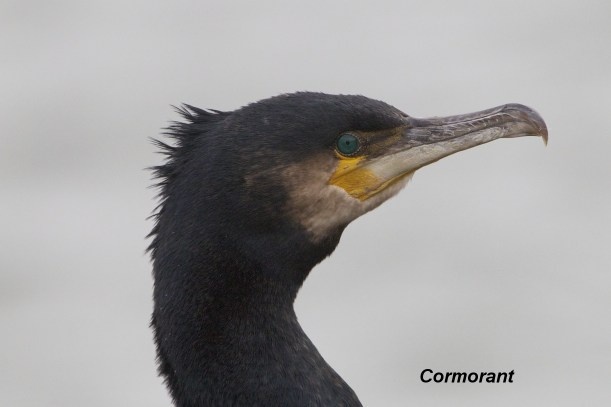

FRIDAY
18 JANUARY 2013
Richard
Somerscocks sent an up date on a few of his Findhorn
sightings since the last report on Jan 13.
"Just opposite
Findhorn Bay there is a large area of forrestry -
Culbin Forest. A couple of days ago I took a walk
through it to the coast, which is a fairly remote
spot. Plenty of waders around including quite a number
of Knot including some that were feeding quite
close to where I was.

A flock of around 20
Bar-tailed Godwit were also visible. We also
have around 50 in Findhorn Bay although there are no
Black-tailed Godwits at the moment.

On the walk back
through the forest Scottish Crossbills and
Crested Tits were feeding in the tree tops. They are
difficult to see and even more difficult to
photograph!
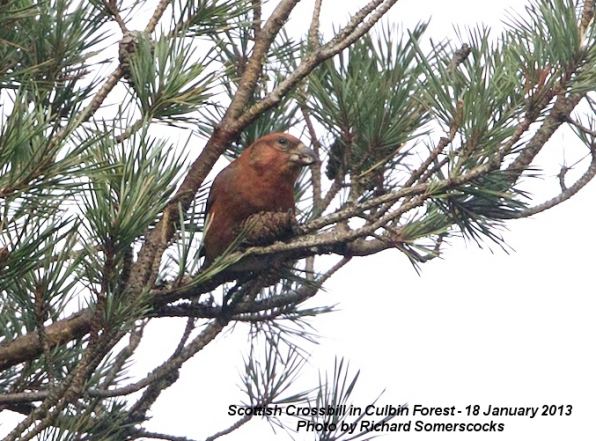
Today was sunny and I
took a walk to the end of the bay to look at the seals
in the early morning sun. The picture attached shows a
group a Grey Seals with the male sitting behind
the females watching over them. We also get Common or
Harbour Seals but there weren't many around this
morning.
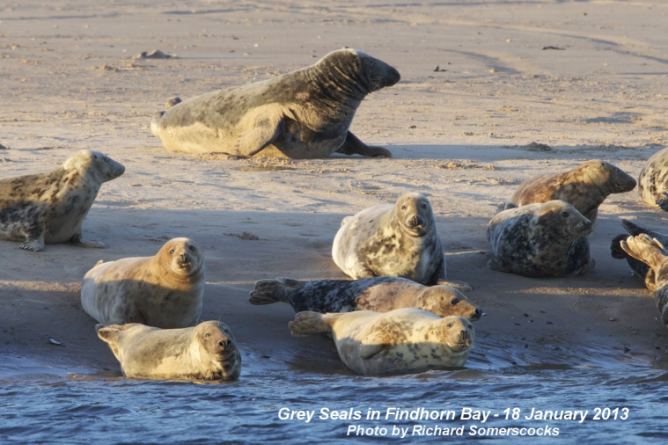
In the bay there are
still a few Long-tailed Ducks around. This male
was photographed late yesterday afternoon. It appeared
to have something stuck in its throat as it was trying
to cough something up. The photo seems confirm this as
there is a definite bump in the neck. There was no
sign of it this morning so hopefully it is
alright."
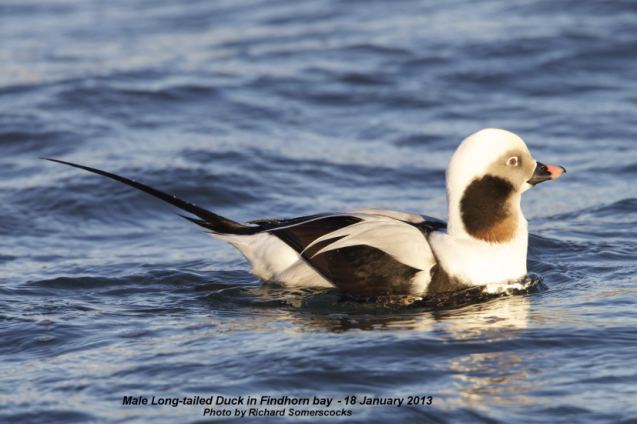
SATURDAY
12 JANUARY 2013
Richard Somerscocks
reports from his new home in Findhorn in Northern
Scotland.
"I have only been back
a couple of days having spent New Year away and on the
whole it is fairly quiet up here. The most interesting
sighting has been a Great Northern Diver that
has been coming into the bay and it was present again
this morning.
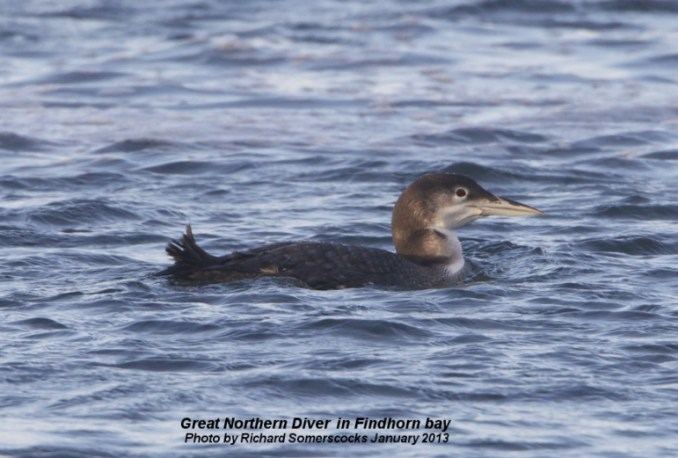
There have also been
up to 4 Shags in the bay, as well as the usual
Cormorants. Ducks include the Red-breasted Mergansers,
Goldeneye and Long-tailed Ducks. Most of the Wigeon we
had last month seem to have moved on
somewhere.
Shag
(with distinctive steep forehead) with Long-tailed
Duck swimming by

At home I had a
sighting yesterday lunchtime of 18 Waxwings that
landed in bushes just in front of my house. They then
moved up to the top of a fir tree in my garden and 3
landed on the wind-vane on top of a dinghy's mast
which was quite a comical sight."
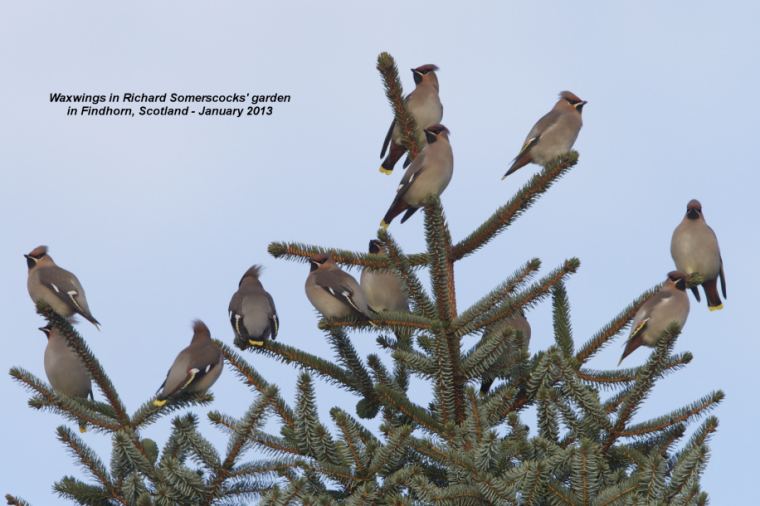
SUNDAY
DECEMBER 16 - 2012
Richard Somerscocks
went out with his camera today in Findhorn in Northern
Scotland and got these two beautiful photos to cheer
us up during this miserable spell of weather.
Harbour
Seals
The first photo is of
about 80 Common (or Harbour) Seals basking in the
early morning sunlight. The picture shows the seals in
the foreground and looks out across the Moray Firth
towards the Cromarty Firth with the snow draped hills
of the Northern Highlands in the background.
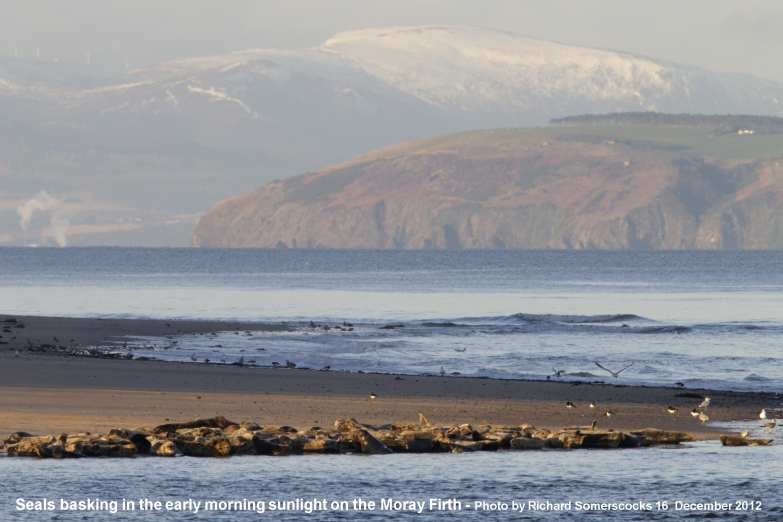
Scotland as a whole is
home to around 90 per cent of Britain's seal
population, many of which can be seen at Moray Firth.
The Common Seal, a member of the pinniped family, is
often nicknamed a Harbour Seal as it is frequently
found in shallow inland waters and does not usually
venture more than 20km from the shore.
Bottlenose
Dolphins
Richard also spotted a
group of around 35 Dolphins making their way eastwards
along the coast. Most were just on or near the surface
but a few were putting on a spectacular show leaping
out of the water, like this acrobatic fellow.
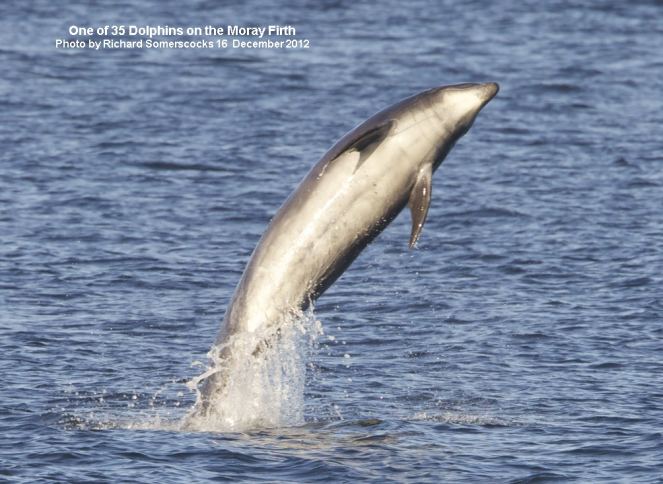
Bottlenose Dolphins
are cetaceans, or small-toothed whales, with rounded
heads and long snouts, sickle-shaped dorsal fins,
broad flippers, blowholes and rows of short, sharp
teeth. One of the most intelligent and sociable marine
mammals, Dolphins are often seen swimming alongside
boats at speeds of up to 20 miles per hour, jumping as
high as six metres out of the water in a dramatic
display. Bottlenose Dolphins tend to live in small
groups of up to 12 others, called pods, which are
mainly made up of females and their young. Sometimes a
number of pods will join together to make
congregations of hundreds, where a kind of hierarchy
has often been noted, although the male of the species
prefers to live alone or in a smaller pod of just two
or three.
SATURDAY
DECEMBER 15 - 2012
Richard Somerscocks
sent me a report about the waders currently in the
Findhorn area in Northern Scotland. As this will
probably be his last update for a while, Richard
wishes all his friends in Emsworth a Happy Christmas
and a prosperous New Year.
The
waders of Findhorn bay
"I mentioned last time
that I would give you a summary of the waders and so
this report is a quick run through of what is around
at the moment. Black-tailed Godwits really just
pass through in Autumn and Spring. They disappeared by
mid November and I had assumed that they had all moved
south. However on 5 Dec I saw another two which was a
bit unexpected so perhaps there are a few that will
try and survive the winter, but this would be quite
unusual. The Bar-tailed Godwits on the other
hand are here in quite reasonable numbers - anything
up to 90. These are expected to stay the
winter.

Redshank are
common. I saw a flock of 130 a couple of days ago in
one area of Findhorn bay and there are probably at
least 200 elsewhere. A small group of around 30
Turnstones are a regular sight on the shoreline
by the village. Other small waders include Dunlin
and there were at least 250 roosting on the
shoreline at high tide today along with 25
Knot. I suspect this is only a small proportion
of the total population in the bay at the moment.
Curlew are scattered around the bay and I saw a
group of 115 on one of the fields by the bay a couple
of days ago. Oystercatchers are also widely
scattered around the bay but will gather in large
flocks to roost at high water - typically over 400.
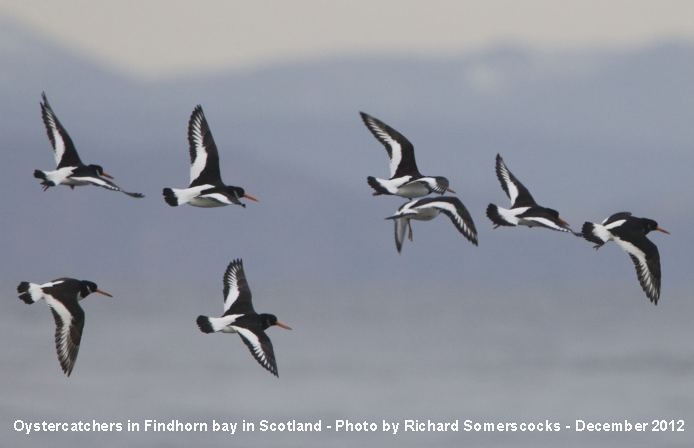
There is also a group
of around 100 Golden Plover on the bay. Lastly,
on the beach we are seeing a few Sanderling and
also Ringed Plover. I have only seen a few Ringed
Plover although their numbers are likely to rise
again later in the winter as they are resident
breeders over the summer months. The Ringed Plover
photo was taken in August but the rest were all taken
this month.
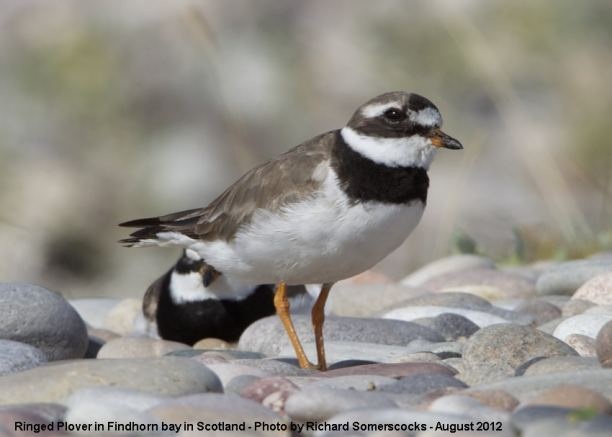
SUNDAY
DECEMBER 3 - 2012
Richard Somerscocks
sent the following report from his new home in the
dark and frozen north of Scotland. I have included
only a small selection of the photos Richard sent.
"Its wet, dark and
cold here and in fact there has been quite a bit of
snow just inland, so not much birdwatching today. I
have been going through and updating some of my photos
and I thought I would send you an update, and today I
will concentrate on the ducks seen at Findhorn. There
is quite a good selection of species to be seen, both
in the bay and the sea ducks just offshore.
In the bay the
Wigeon are the most numerous with several
hundred in the bay at any given time. Most tend to
stay on the opposite side and are difficult to get
very close to, but a few will come across to this side
of the bay. Teal are only seen in very small
numbers and keep themselves fairly well concealed.
Mallard are a common sight but not in any great
numbers.
Other bay ducks
include Pintail and on occasions recently we
have seen 50+. A few Goldeneye are usually
showing quite well on this side, but again there are
quite a lot more further away on the other side of the
bay. The Red-breasted Mergansers I mentioned in
my last update and there are usually about 12 of these
to be seen at the moment. The Goosanders which
were around a few weeks ago seem to have moved on,
although a few drakes are still around. When you see
them with the Mergansers it is quite noticeable how
much bigger they are.
The Long-tailed
Ducks are really sea ducks but quite a few, mostly
juveniles and females, are regularly seen on the bay.
The males generally stay out at sea, although a few
have been on the bay recently. There is quite a wide
variation in the plumages when you see the flocks of
juveniles and females.

Eiders are a
common sight along the coastline and they tend to
gather in large rafts on the sea although their
numbers have dropped a bit in the last few weeks. A
lone King Eider is also with the Eiders just
along the coast from here.
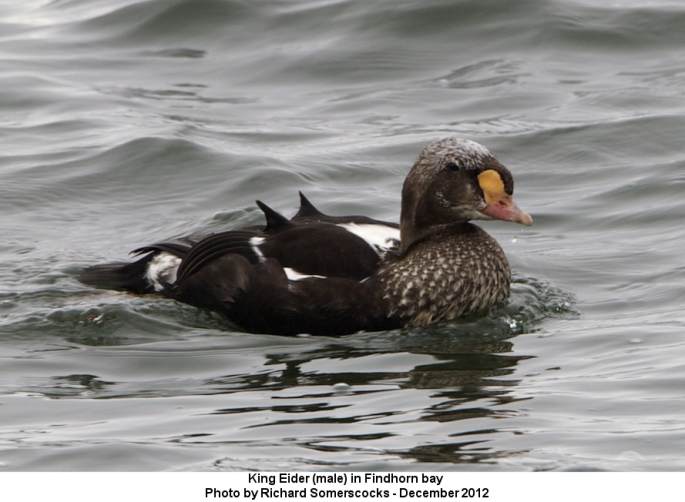
The other sea ducks
seen off the coast are Scoters, both Common and
Velvet. These tend to gather in small groups of 4-10
and are often quite a bit off shore, so are not easy
to photo. Lastly, we also get quite a lot of Grebes.
The Little Grebes are seen feeding in the
shallow water along the shore of the bay and there are
usually about 4-6 just by Findhorn. Offshore we also
get Slavonian Grebes and these are frequently
feeding with the Velvet Scoters - again not
very close to the shore and being fairly small birds
they are also difficult to photograph.
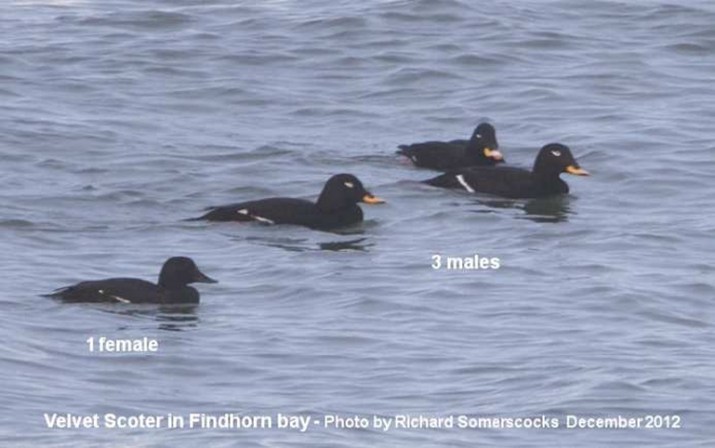
I will try and give an
update on the waders sometime, but this is probably
more than enough information for the time being. A
selection of photos attached which illustrate most of
the ducks mentioned."
FRIDAY
NOVEMBER 30 - 2012
Red-breasted
Mergansers
Richard Somerscocks
has had some splendid Red-breasted Mergansers in the
Findhorn bay in Northern Scotland. Richard said there
were 13 this morning, most of which were females.
There were 5 others just offshore although these were
mainly males. He sees the ones in the bay catching
fish quite regularly.
Here
is a female Red-breasted Merganser with a small
flounder .
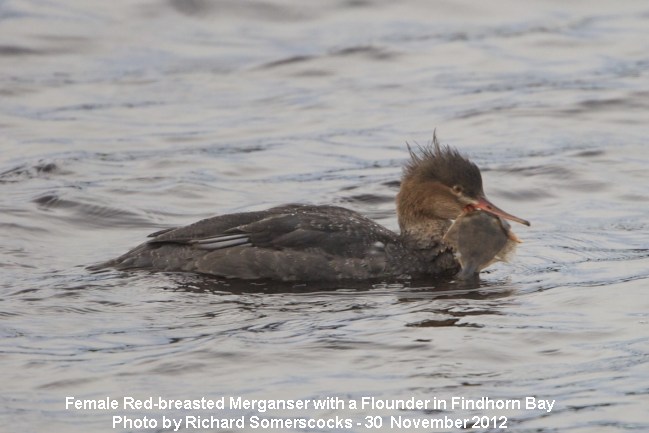
Richard
also gets good views of the males offshore displaying.
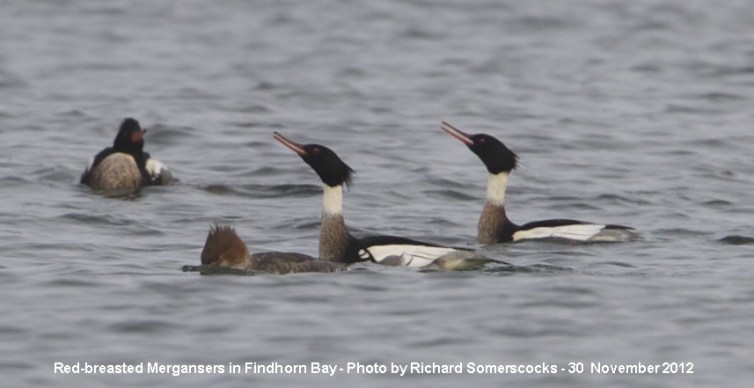
TUESDAY
NOVEMBER 20 - 2012
Richard Somerscocks
has sent a news up date of yet more sightings of
Waxwings from his home town in northern Scotland. He
saw another flock of 10 this morning in Forres which
is a town neighbouring Findhorn. Here is Richard's
photo of one of them to whet our appetites for their
arrival down south.

Richard found a flock
of 32 Fieldfares feeding in the same Rowan
trees, with rapidly disappearing berries. Large flocks
have been seen around the north of Scotland in the
last few weeks: 350 in Lerwick, 250 in Ullapool, 420
in Aberdeen, and the largest flock at the Kyle of
Lochalsh on the west coast which numbered some 1200.
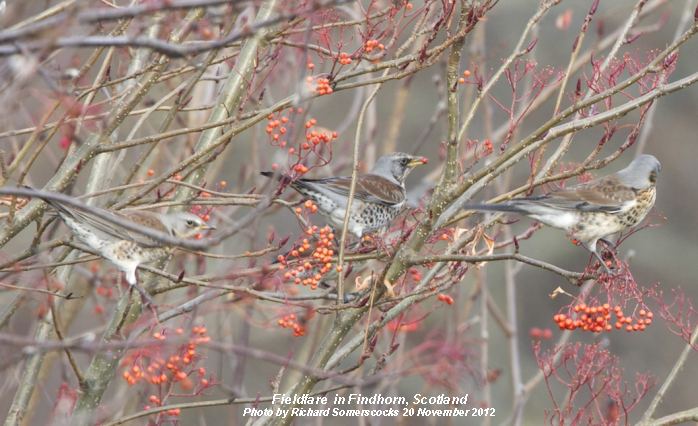
NOVEMBER
16 2012
Richard Somerscocks
managed to spot some Waxwings today and as
promised he sent some pictures - just to make us feel
really envious! Richard had a very large flock in the
country about 10 miles south of Findhorn. When he got
home he counted 122 on his photos. Here are a good few
of them in this shot. They are getting a lot of
reports at the moment so it looks like a good year.
But will they get down here - 600 miles to go!
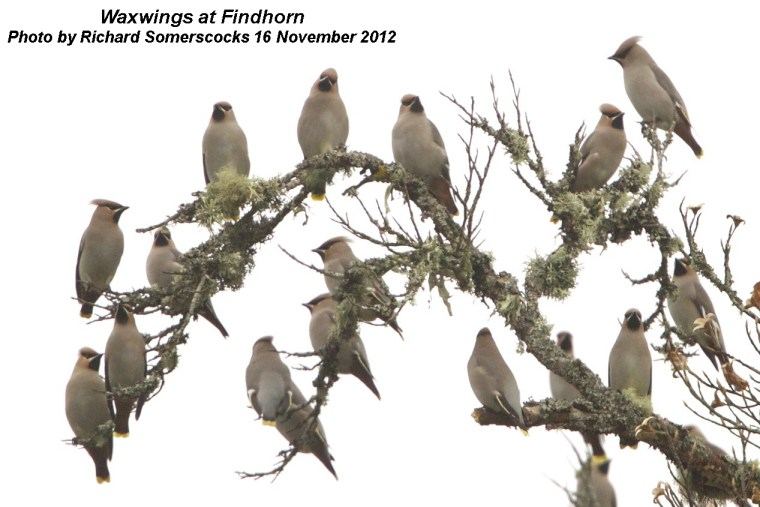
Back at Findhorn Bay
the numbers of Geese are an impressive sight. They
roost on the bay overnight and depart at first light
to feed on the nearby fields before returning just
before dusk. Richard witnessed the spectacle yesterday
when a huge flock of around 4000 Pink-footed
Geese returned to the bay mid-afternoon. Richard
says it is difficult to capture the spectacle from
photos and you certainly cannot get an impression of
the noise they make, but he sent the following image
of a small proportion of the flock about to land on
the bay.
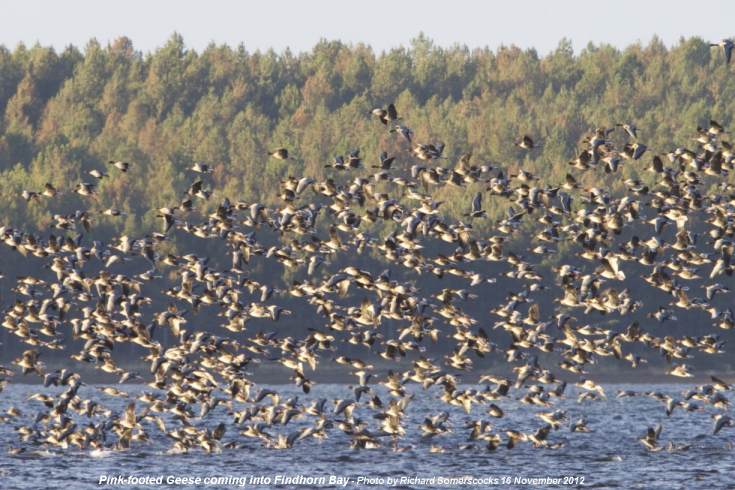
Offshore they are
getting quite a few sightings of Divers and there is a
juvenile Red-throated Diver which is currently
coming in very close and giving excellent views. This
picture was taken this morning.
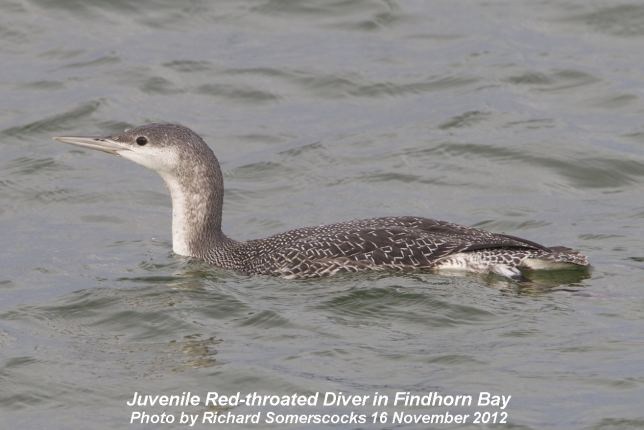
Most of the Divers,
particularly the Black-throated Divers, stay further
offshore. There were also a number of Slavonian Grebes
feeding with the Velvet Scoters.
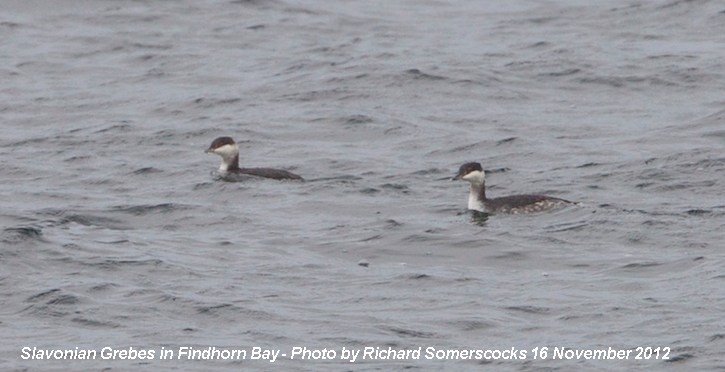
NOVEMBER
14 2012
At my request, Richard
Somerscocks sent me this fine image of two Twite.
Richard tells me they were seen on 1 Nov at Burghead,
a small fishing village about 7 miles east of
Findhorn. The local bird recorder says they are
relatively uncommon in Moray and apparently most of
the sightings are in the Findhorn area. Although he
suspects there may be more among the flocks of
Linnets, but they simply don't get looked at.
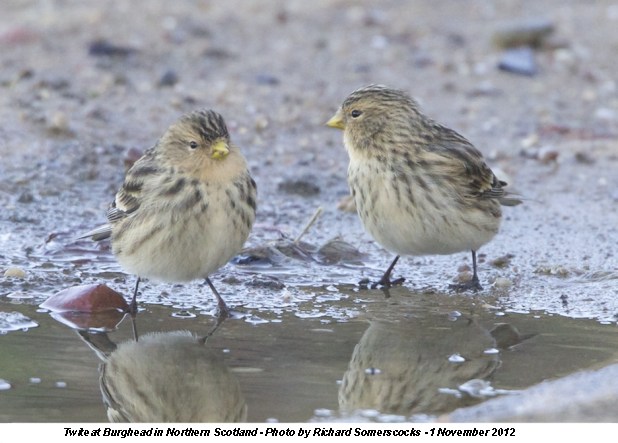
The Birds in Moray and
Nairn web site has a number of Richard's photos. See .
. . http://www.birdsinmorayandnairn.org/bird-recording/recent-records/
There are also many sightings of Waxwings on the web
site, though Richard has yet to see one. If he does he
promises to send us a photo to savour! Maybe, we shall
get some down here this year?
The last Twite I saw
locally were two on the shore at Langstone near the
entrance to the Langbrook Stream on 14 January 2003. I
think there were three sighted, but I only saw two.
Here is my photo from the time.

NOVEMBER
11 2012
As a supplement to
yesterday's news, Richard Somerscocks says they never
get Spotted Redshank up in Scotland, but make up for
this with masses of Common Redshank.
Here
is Richard's shot of a roosting flock of Common
Redshank in Findhorn bay.
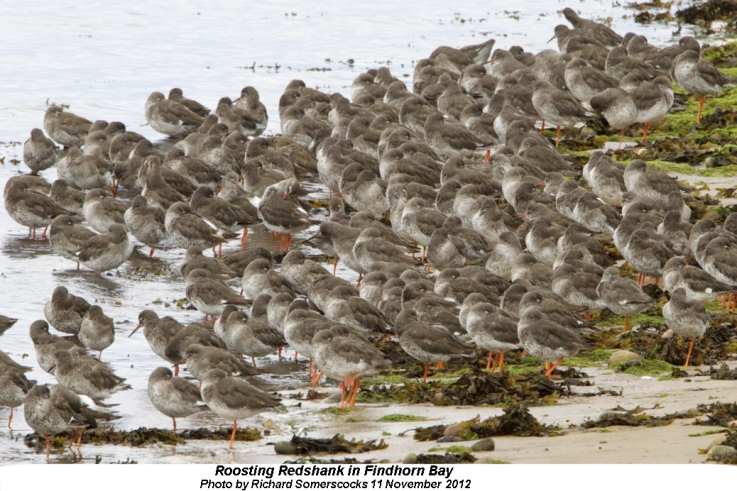
NOVEMBER
10 2012
Richard Somerscocks
provided the following news up date from his new home
in Findhorn in Northern Scotland
"Black-tailed
Godwits are still present in Findhorn Bay. I
counted 6 today and that included WN+OY flag which has
now been with us for about 2 weeks.
It has been fairly
windy here for the last few days which has made
birdwatching more challenging. Quite a lot of ducks
are in the bay though at the moment, including both
Red-breasted Mergansers and Goosanders. These
birds, particularly the females, can look fairly
similar at a distance but when seen close up the
differences become apparent. The Mergansers tend to
favour the more open sea, whereas the Goosanders stay
almost exclusively in the bay. This behaviour was also
apparent in the sightings I got when I was at
Emsworth. The Mergansers were often seen off Thorney
Island and the few sightings I had of Goosanders
tended to be on Great Deep.
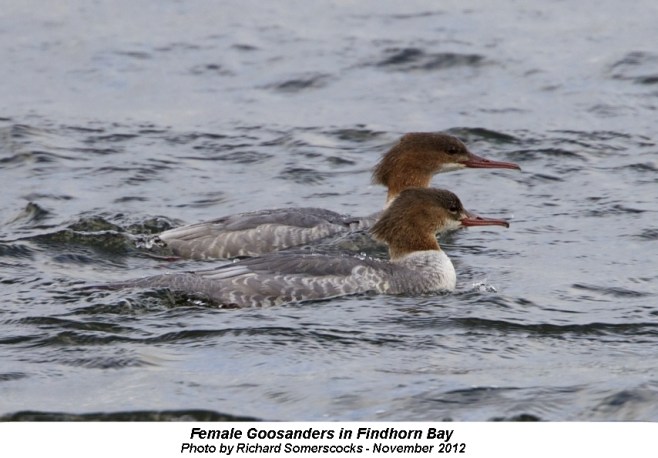
I notice that you are
getting Pintails at Emsworth and we also have
around 50 in Findhorn Bay at the moment.
Another bird I saw
yesterday were a number of Sanderlings. They
tend to favour long sandy beaches where they can rush
around endlessly feeding by the water's edge. It does
make photographing them difficult! I cannot recall
seeing them at Emsworth but I expect somewhere like
the Witterings may have some. The ones I saw were on
the beach at Lossiemouth which is just along the
coast.
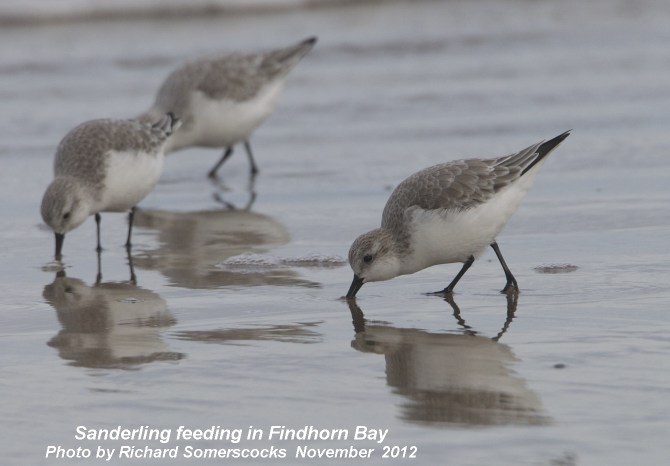
Finally, on the shore
I have also seen a few Snow Bunting here at
Findhorn.
